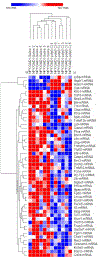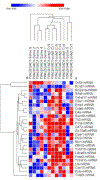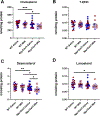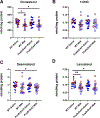Interaction of maternal immune activation and genetic interneuronal inhibition
- PMID: 33600830
- PMCID: PMC8006572
- DOI: 10.1016/j.brainres.2021.147370
Interaction of maternal immune activation and genetic interneuronal inhibition
Abstract
Genes and environment interact during intrauterine life, and potentially alter the developmental trajectory of the brain. This can result in life-long consequences on brain function. We have previously developed two transgenic mouse lines that suppress Gad1 expression in parvalbumin (PVALB) and neuropeptide Y (NPY) expressing interneuron populations using a bacterial artificial chromosome (BAC)-driven miRNA-based silencing technology. We were interested to assess if maternal immune activation (MIA), genetic interneuronal inhibition, and the combination of these two factors disrupt and result in long-term changes in neuroinflammatory gene expression, sterol biosynthesis, and acylcarnitine levels in the brain of maternally exposed offspring. Pregnant female WT mice were given a single intraperitoneal injection of saline or polyinosinic-polycytidilic acid [poly(I:C)] at E12.5. Brains of offspring were analyzed at postnatal day 90. We identified complex and persistent neuroinflammatory gene expression changes in the hippocampi of MIA-exposed offspring, as well in the hippocampi of Npy/Gad1 and Pvalb/Gad1 mice. In addition, both MIA and genetic inhibition altered the post-lanosterol sterol biosynthesis in the neocortex and disrupted the typical acylcarnitine profile. In conclusion, our findings suggest that both MIA and inhibition of interneuronal function have long-term consequences on critical homeostatic mechanisms of the brain, including immune function, sterol levels, and energy metabolism.
Keywords: Acylcarnitines; Interneuron; Maternal immune activation; Neuroinflammation; Schizophrenia; Sterol profile.
Copyright © 2021 Elsevier B.V. All rights reserved.
Conflict of interest statement
Conflict of Interest
The authors declare no conflict of interest that is in any form related to the presented material, experiments, or outcomes.
Figures






Similar articles
-
Maternal immune activation alters glutamic acid decarboxylase-67 expression in the brains of adult rat offspring.Schizophr Res. 2016 Mar;171(1-3):195-9. doi: 10.1016/j.schres.2016.01.041. Epub 2016 Jan 29. Schizophr Res. 2016. PMID: 26830319 Free PMC article.
-
Association of aberrant neural synchrony and altered GAD67 expression following exposure to maternal immune activation, a risk factor for schizophrenia.Transl Psychiatry. 2014 Jul 29;4(7):e418. doi: 10.1038/tp.2014.64. Transl Psychiatry. 2014. PMID: 25072323 Free PMC article.
-
TSPO activation ameliorates maternal immune activation induced PV interneuron deficits via BDNF/TrkB signaling.Psychopharmacology (Berl). 2025 Jun;242(6):1303-1319. doi: 10.1007/s00213-024-06728-0. Epub 2024 Dec 2. Psychopharmacology (Berl). 2025. PMID: 39621042
-
Effect of Immune Activation during Early Gestation or Late Gestation on Inhibitory Markers in Adult Male Rats.Sci Rep. 2020 Feb 6;10(1):1982. doi: 10.1038/s41598-020-58449-x. Sci Rep. 2020. PMID: 32029751 Free PMC article.
-
LPS versus Poly I:C model: comparison of long-term effects of bacterial and viral maternal immune activation on the offspring.Am J Physiol Regul Integr Comp Physiol. 2022 Feb 1;322(2):R99-R111. doi: 10.1152/ajpregu.00087.2021. Epub 2021 Dec 7. Am J Physiol Regul Integr Comp Physiol. 2022. PMID: 34874190 Free PMC article. Review.
Cited by
-
Maternal Inflammation During Pregnancy and Offspring Brain Development: The Role of Mitochondria.Biol Psychiatry Cogn Neurosci Neuroimaging. 2022 May;7(5):498-509. doi: 10.1016/j.bpsc.2021.11.003. Epub 2021 Nov 17. Biol Psychiatry Cogn Neurosci Neuroimaging. 2022. PMID: 34800727 Free PMC article. Review.
-
Genes Participating in the Ensheathment of Neurons Are Affected by Postnatal Stress and Maternal Immune Activation in the Pituitary Gland.Genes (Basel). 2023 Apr 28;14(5):1007. doi: 10.3390/genes14051007. Genes (Basel). 2023. PMID: 37239367 Free PMC article.
-
Neonatal Hypoxic-Ischemic Brain Injury Alters Brain Acylcarnitine Levels in a Mouse Model.Metabolites. 2022 May 22;12(5):467. doi: 10.3390/metabo12050467. Metabolites. 2022. PMID: 35629971 Free PMC article.
References
-
- Alexopoulou L, et al., 2001. Recognition of double-stranded RNA and activation of NF-kappaB by Toll-like receptor 3. Nature 413, 732–8. - PubMed
-
- Benes FM, Berretta S, 2001. GABAergic interneurons: implications for understanding schizophrenia and bipolar disorder. Neuropsychopharmacology 25, 1–27. - PubMed
Publication types
MeSH terms
Substances
Grants and funding
LinkOut - more resources
Full Text Sources
Other Literature Sources
Molecular Biology Databases
Miscellaneous

